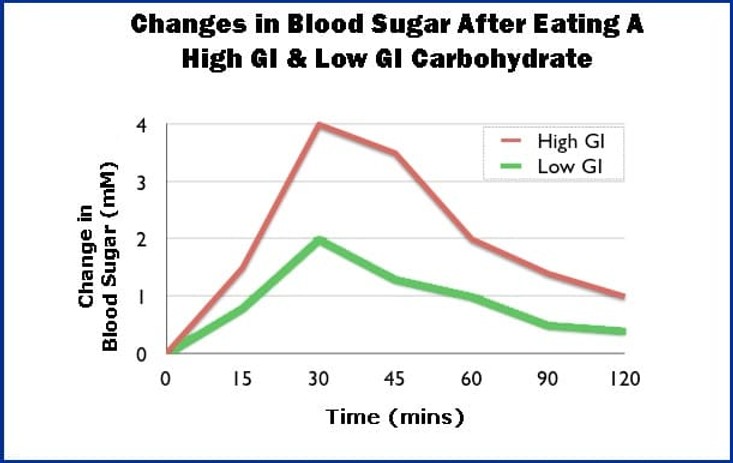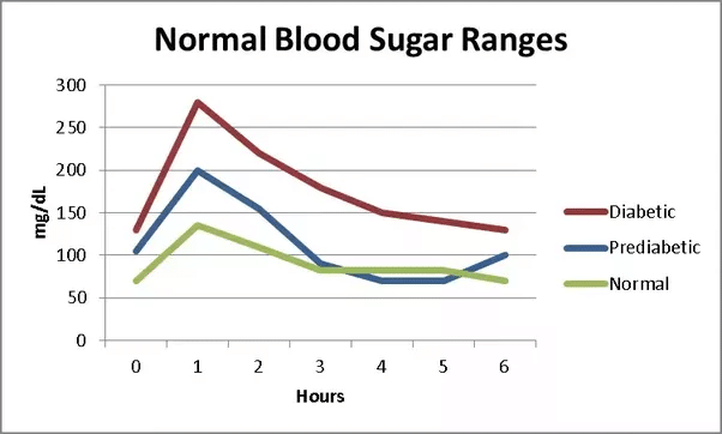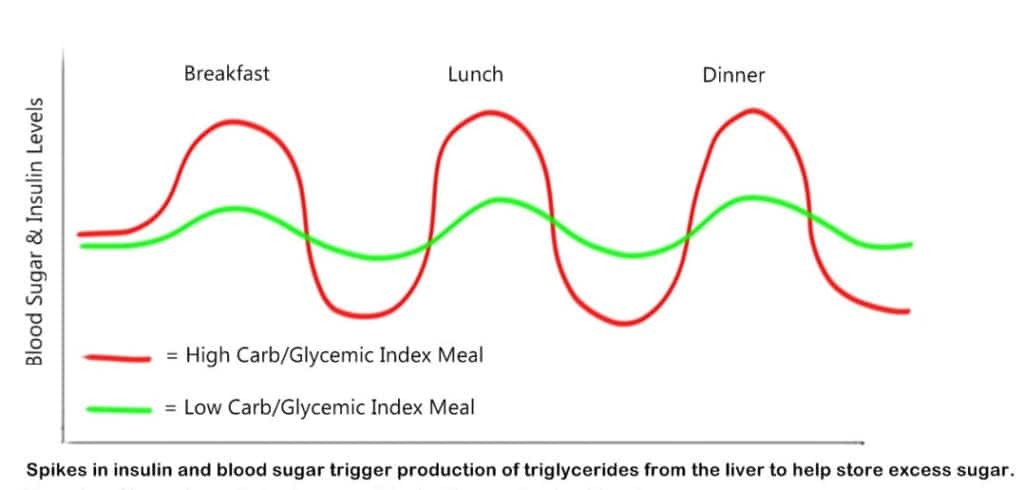Every time we eat, our digestive system breaks down the macronutrients (carbs, protein and fats) into “smaller pieces”. For example, carbs are broken down into glucose.
Note: If you prefer to watch a video explaining how added sugar makes you fat, click here and a new window will open. You can watch the video and come back to this page afterward.
Glucose comes from the Greek word for “sweet”. Some foods are sweeter than others, and some foods contain more sugar (glucose) than others.
The glucose is absorbed into our bloodstream. The sweeter (and higher in sugar) the food we eat higher is, the higher the levels of sugar in our blood will be.
Glycogen
When you eat carbohydrates, the carbs are converted into glucose and used for instant energy. If there is any left over, this excess of “sweet” (glucose) is then converted into glycogen. Glycogen is just glucose and water bound together into a single molecule. Glycogen is stored in the liver and in the muscles. Glycogen is stored energy for later use. Your muscles use it during exercise and liver glycogen is released if blood glucose levels start to fall, such as if you miss breakfast. [This is why fasting speeds up weight loss!]
It’s estimated that our glycogen storage capacity is around two thousand calories – 400 in your liver and the rest in your muscles.
Fat
Once our glycogen stores are full, which doesn’t take long as our storage capacity is small, (around 2000 calories) we start storing unused glucose as fat.
If we continue to eat more carbs than we need, with no physical activity, we continue to generate more fat so that excess energy can be stored.
High sugar foods – Refined Carbs
- Breakfast cereals
- Packaged fruit juices and soda
- Soft drinks (nothing soft about them, they’re high in sugar)
- Sports energy drinks
- Candy
- Flavored yogurt
- Flavored milk and sweetened non-dairy milks e.g. almond milk, soya milk etc.
- Salad dressings
- Commercial sauces (ketchup, barbecue, tomato)
- Vitamin Water
- Flavored green tea and coffee
- Ready to eat soups
- Granola bars
- Commercial granola
- Iced tea and iced coffee drinks
When you check the food label on any of the previously listed processed foods or drinks, you will see that they all contain high quantities of sugar.
The American Heart Association recommends that adults consume no more than nine teaspoons of sugar per day. In America, most adult men consume 25 teaspoons of sugar per day, and most women consume about the same. That’s a whole lot of sugar.
But, besides these obvious high sugar foods (learn how to read food labels here) there are other not-so-obvious-foods that also cause insulin spikes that can result in fat production and storage.
To help you identify which foods raise high blood sugar levels the most, you can use the Glycemic Index, GI for short.
Glycemic Index ranks foods from 0 to 100. The higher the number, the higher food will increase your blood glucose levels.
Examples:
- Apple (raw) 36
- Orange (raw) 43
- Kidney beans 24
- Popcorn 65
- White Bread 75
- White Rice (boiled) 73
- Sucrose (table sugar) 65
As you can see, there are Low GI Foods (55 or less), Medium GI foods (56-69), and High GI foods (70 or more).
The fruit and whole wheat have a low glycemic index, causing only a small increase in blood sugar. [BUT, sugar in fruit is in the form of fructose, which we can't break down and digest, so it goes straight to the liver and stored as fat, contributing to a condition called fatty liver. Hence why Dr. Bowers does not recommend fruit for the keto diet, aside from berries.]
As foods become more processed, the GI gets higher, like couscous and popcorn. All processed food has a high glycemic index, because processed food contains very little fiber and is very high in sugar (sucrose, fructose, glucose).
High GI foods are more likely to end up being converted to fat as they flood your blood with lots of glucose at the same time. They are broken down very quickly and that spells trouble for your insulin levels and your fat stores.

After the sugar spike we then have a sugar crash to deal with and that causes cravings, feelings of hunger, and can cause our mood to worsen – we need another hit of sugar to feel happy again.

To avoid high sugar levels in our blood, which would lead to death, our pancreas produces a hormone called insulin to remove all the excess sugar (glucose) from our blood.
That’s why after eating, our insulin levels spike. The insulin enters our bloodstream and removes all the excess “sweet” (glucose).
Insulin not only lowers blood glucose and helps to store glucose as glycogen, it also prevents fat burning too.
High sugar and high GI foods cause higher insulin levels because more insulin is needed to remove the sugar excess from the blood. Continuously high levels of insulin can lead to insulin resistance, which is the number one cause of type 2 diabetes. Avoiding high sugar and high GI foods and beverages is the best way to avoid weight gain and prevent type 2 diabetes.

The High Sugar Diet Problem
Processed foods are high in calories and contain too much sugar (glucose) so more fat is created.
High doses of sugar mean that more insulin is required to remove all the sweet (glucose) from the blood. And since our glycogen stores are soon full, that excess sugar is converted into and stored as fat to remove it from the blood.
Why Added Sugar is Everywhere, a quick animation video explaining the hidden formula of Food Companies to make more money. Click here to watch the video (a new window will open)
Today in America, and all over the world, we are living on a high sugar diet. Added sugar is the number one cause of obesity and many metabolic chronic diseases like type 2 diabetes, Chronic High Blood Pressure, heart disease, and even dementia. I’ve published an article about the dangers of added-sugar here Worldwide Sugar is Killing us.
Ditching, or at least reducing the consumption of added-sugar has to be a priority for all of us.
Click here to see how NAET can help with sugar related conditions.
#glycemicindex #sugar #insulin #nutrition #functionalmedicine #keto #ketosisandfasting #ketoiswhereitsat #ketolifestyle #drbowers #allergyandspine

Recent Comments